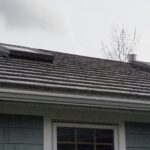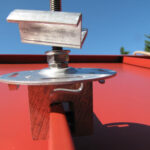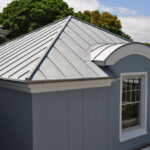Damaged Metal Shingles
FACT
Despite its incredible strength when compared with other roofing materials, metal roofing can still be damaged by heavy falling objects such as tree limbs or large hail. When such incidents occur, metal shingle roofs can have damaged panels capped or replaced.
ANALYSIS
The replacement of metal roof panels should be done as soon as possible to avoid interior damage to the structure. Because metal roofing shingles normally interlock surrounding panels, repair requires an understanding of that product’s fastening and locking system. Some special tools may be required. When removing panels, care should be taken not to damage surrounding panels. Materials like aluminum and copper have a more flexible structure and can be repaired more easily than some steel products. Once damaged products are removed, the substrate and underlayment should be inspected and repaired if necessary. In some cases, it will be most efficient to remove a roof section back to the damaged area, making it easier and faster to complete the work correctly.
SOLUTION
Remove the damaged panel and its fasteners. Fold out, bend, or open the locks of the replacement panel and surrounding panels to enable the replacement panel to rest in position. Force the locks together by bending the metal back to its original form. Fasten the panel to the substrate. Open the bottom lock of the course of panels above the replaced panel and fold the lock into the lock of the replacement panel below it. A siding zip tool, rubber mallet, or pliers can help make the panel re-engage to its original state. Another method used to repair damaged panels is to cap or overlay the damaged panel with the same material. This is done by removing the locks on the replacement panel and forcing it over the damaged panel. Usually, sealant is used to hold the cap permanently in place. Remember, if the roof damages are substantial, total replacement may be the best solution; based upon age and weathering characteristics, capped and replaced panels may not exactly match the surrounding material.




